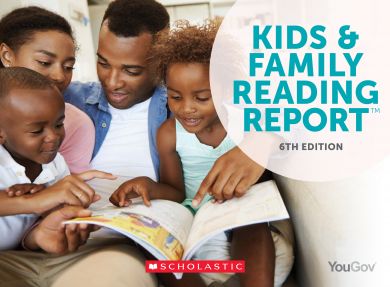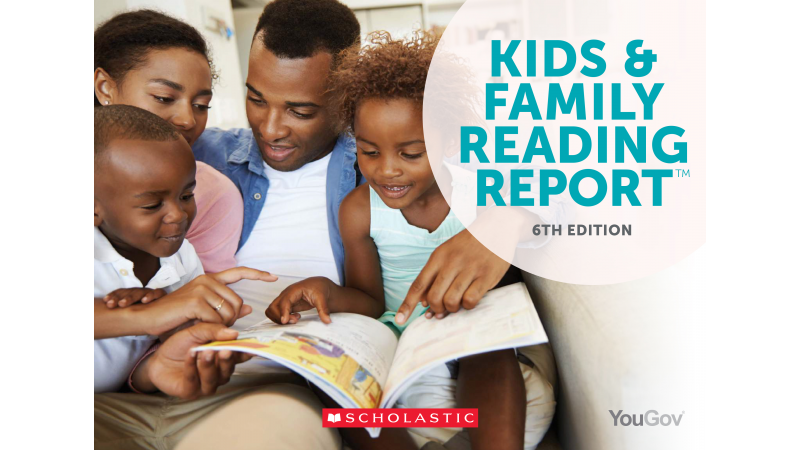 Did you know the average household with children ages 0–17 has 104 children’s books in the home?Did you also know that only half of all parents with children ages 6–17 (48%) have heard of the “summer slide”? These are just a few things we discovered in the sixth edition of the Kids & Family Reading Report™, a biannual national survey of children ages 6–17 and their parents – as well as parents of kids ages 0–5 – while exploring families’ attitudes and behaviors around reading. (Check out the coverage we've already received from the Associated Press!)
Did you know the average household with children ages 0–17 has 104 children’s books in the home?Did you also know that only half of all parents with children ages 6–17 (48%) have heard of the “summer slide”? These are just a few things we discovered in the sixth edition of the Kids & Family Reading Report™, a biannual national survey of children ages 6–17 and their parents – as well as parents of kids ages 0–5 – while exploring families’ attitudes and behaviors around reading. (Check out the coverage we've already received from the Associated Press!)
Since the first edition in 2006, the Kids & Family Reading Report has looked at kids’ attitudes and behaviors towards reading books for fun. To continue to drive conversations and to keep up-to-speed on kids’ reading habits, the sixth edition of the report focuses on what parents and kids want in books and characters – including views on diversity in children’s books, reading aloud – and reading from birth, kids’ attitudes and behaviors around reading for fun, favorite children’s books, summer reading and kids’ favorite books and series. For the first time, the report includes focus on sections that highlight data among Hispanic and African-American families.
Some highlights from the report:
The average home with children ages 0–17 has 104 children’s books; however, households with yearly income less than $35,000 only have 69 children’s books, Hispanic families have 91 children’s books, and African-American families have 67 children’s books on average in the home.
Kids and parents agree that they just want a “good story” or a funny read: When looking for children’s books to read for fun, both kids (37%) and parents (42%) “just want a good story,” and a similar percentage want books that make kids laugh.
Defining diversity in children’s books: Parents with kids ages 0–17 share that diversity in books for kids and teens includes “people and experiences different than those of my child” (73%), “various cultures, customs, or religions” (68%), “differently-abled people” (51%), “people of color (47%), and “LGBTQ people” (21%). African-American families are more likely than non-African-American families to say diversity means the inclusion of “people of color” (62% vs. 45%). For a list of multicultural book recommendations, click here.
More parents are reading aloud to children before three months:Three-quarters of parents with children ages 0–5 (77%) say they started reading aloud to their child before age one, with 40%—up from 30% in 2014—saying they began when their child was less than three months old.
The frequency of reading aloud to young children 5–7 days a week has increased since 2014 among parents with kids ages 3–5 (55% to 62%), yet there are still significant drops in frequency after ages 5 and 8.
Read aloud time is enjoyed by families: Kids ages 6–11 and their parents agree that they love(d) or like(d) read aloud time a lot with the top reasons being it is a special time together (72% and 77%, respectively) and reading together is fun (66% and 67%).
Six in 10 children ages 6–17 agree “I really enjoy reading books over the summer” (62%), and 80% agree that summer reading will help them during the school year.
One in five 12–17-year-olds and one in five kids from lower-income families do not read any books at all over the summer. On average, kids read eight books over the summer.
Awareness of the “summer slide” varies according to household income: Nearly half of all parents with children ages 6–17 (48%) have heard of the “summer slide,” with lower-income parents far less likely to have heard of this (38%).
Books or series all kids should read: Parents told us the books or series they felt all children should read and they include Harry Potter, Diary of a Wimpy Kid, The Magic Tree House, Dr. Seuss and The Chronicles of Narnia.
You can read the official press release here and learn more about the data and download the full report here. Be sure to join the conversation online using #KFRR.





